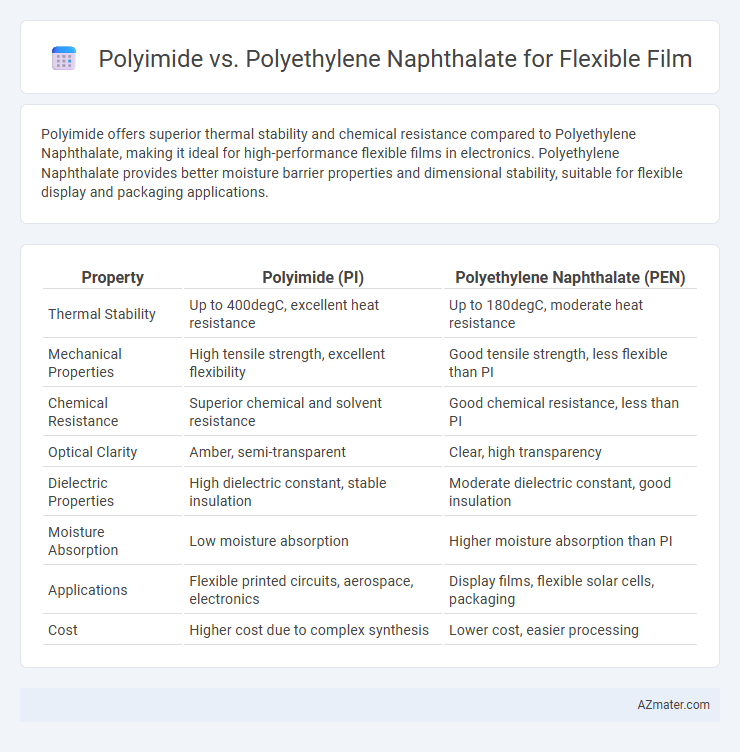Polyimide offers superior thermal stability and chemical resistance compared to Polyethylene Naphthalate, making it ideal for high-performance flexible films in electronics. Polyethylene Naphthalate provides better moisture barrier properties and dimensional stability, suitable for flexible display and packaging applications.
Table of Comparison
| Property | Polyimide (PI) | Polyethylene Naphthalate (PEN) |
|---|---|---|
| Thermal Stability | Up to 400degC, excellent heat resistance | Up to 180degC, moderate heat resistance |
| Mechanical Properties | High tensile strength, excellent flexibility | Good tensile strength, less flexible than PI |
| Chemical Resistance | Superior chemical and solvent resistance | Good chemical resistance, less than PI |
| Optical Clarity | Amber, semi-transparent | Clear, high transparency |
| Dielectric Properties | High dielectric constant, stable insulation | Moderate dielectric constant, good insulation |
| Moisture Absorption | Low moisture absorption | Higher moisture absorption than PI |
| Applications | Flexible printed circuits, aerospace, electronics | Display films, flexible solar cells, packaging |
| Cost | Higher cost due to complex synthesis | Lower cost, easier processing |
Introduction to Flexible Films
Polyimide and Polyethylene Naphthalate (PEN) are prominent materials used in flexible films due to their exceptional thermal stability and mechanical strength. Polyimide offers superior heat resistance up to 400degC, making it ideal for high-temperature electronic applications, while PEN provides excellent dimensional stability and transparency with good moisture barrier properties. The choice between Polyimide and PEN for flexible film depends on specific requirements such as thermal endurance, flexibility, and optical characteristics in industries like flexible displays, solar cells, and advanced electronics.
Overview of Polyimide (PI)
Polyimide (PI) is a high-performance polymer widely used in flexible films due to its exceptional thermal stability, chemical resistance, and mechanical strength. Its dielectric properties and ability to maintain integrity under extreme temperatures make it ideal for advanced electronics and flexible circuit applications. Compared to Polyethylene Naphthalate (PEN), PI offers superior heat resistance and durability, enabling longer lifespan in harsh environments.
Overview of Polyethylene Naphthalate (PEN)
Polyethylene Naphthalate (PEN) is a high-performance polyester film known for its superior thermal stability, excellent chemical resistance, and remarkable dimensional stability, making it ideal for flexible electronic applications. Compared to Polyimide (PI), PEN offers better optical clarity and lower moisture absorption, which enhances its use in display technologies and solar panels. Its balanced mechanical strength and barrier properties position PEN as a competitive alternative to polyimide in flexible film markets requiring durability and transparency.
Mechanical Properties: Polyimide vs Polyethylene Naphthalate
Polyimide exhibits superior mechanical strength and thermal stability compared to polyethylene naphthalate, making it ideal for high-performance flexible film applications requiring durability under stress and high temperatures. Polyethylene naphthalate offers excellent tensile strength and dimensional stability but has lower heat resistance and flexibility relative to polyimide. Both materials provide effective mechanical performance, with polyimide better suited for demanding environments and polyethylene naphthalate favored for cost-sensitive, moderate-performance uses.
Thermal Stability Comparison
Polyimide exhibits superior thermal stability compared to Polyethylene Naphthalate (PEN), withstanding continuous use temperatures above 300degC, while PEN typically degrades around 180-200degC. The imide groups in polyimide provide exceptional resistance to thermal oxidation and mechanical integrity at elevated temperatures, making it ideal for high-temperature flexible film applications. PEN offers moderate thermal stability but is better suited for applications requiring lower thermal endurance and cost-effective solutions.
Chemical Resistance: PI vs PEN
Polyimide (PI) exhibits superior chemical resistance compared to Polyethylene Naphthalate (PEN), with excellent stability against solvents, acids, and bases, making it ideal for harsh environments in flexible film applications. PEN offers moderate chemical resistance but tends to degrade faster when exposed to strong chemicals or prolonged chemical exposure. The enhanced aromatic structure of PI contributes significantly to its robust chemical durability, outperforming PEN in maintaining integrity and functionality under aggressive chemical conditions.
Optical and Electrical Properties
Polyimide exhibits superior thermal stability and excellent dielectric strength, making it ideal for flexible film applications requiring high electrical insulation and resilience under extreme conditions. Polyethylene Naphthalate (PEN) offers better optical clarity and ultraviolet resistance, with a higher transmittance in the visible spectrum and lower haze compared to polyimide films. Both materials provide low dielectric constants, but polyimide generally outperforms PEN in sustaining electrical properties at elevated temperatures, while PEN is preferred for optical transparency in flexible display and photovoltaic applications.
Processing and Fabrication Differences
Polyimide films exhibit superior thermal stability and chemical resistance, enabling high-temperature processing methods such as vacuum deposition and photolithography without deformation, unlike polyethylene naphthalate (PEN), which has lower thermal tolerance and limited compatibility with high-temperature processes. PEN offers easier roll-to-roll fabrication due to its dimensional stability and good mechanical strength but requires more stringent temperature control during lamination and metallization steps to prevent film shrinkage and distortion. The choice between polyimide and PEN significantly impacts process parameters, yield rates, and overall device performance in flexible electronics manufacturing.
Typical Applications in Industry
Polyimide films find extensive use in the electronics industry for flexible printed circuits, insulation in high-temperature environments, and aerospace components due to their thermal stability and chemical resistance. Polyethylene naphthalate (PEN) is commonly utilized for flexible displays, solar cells, and packaging applications where dimensional stability and excellent barrier properties are critical. Both materials serve vital roles in flexible film technologies, with polyimide favored for high heat and electrical insulation, while PEN is preferred for optical clarity and moisture resistance.
Cost and Availability Considerations
Polyimide films generally exhibit higher costs due to complex synthesis and specialized processing requirements, while polyethylene naphthalate (PEN) offers more economical availability with broader commercial production footprint. PEN's cost-effectiveness and easier scalability make it preferable for large-volume flexible film applications, whereas polyimide is often reserved for high-performance uses demanding superior thermal and chemical resistance. Availability of polyimide is comparatively limited, impacting lead times and supply chain reliability in flexible electronics manufacturing.

Infographic: Polyimide vs Polyethylene Naphthalate for Flexible Film
 azmater.com
azmater.com